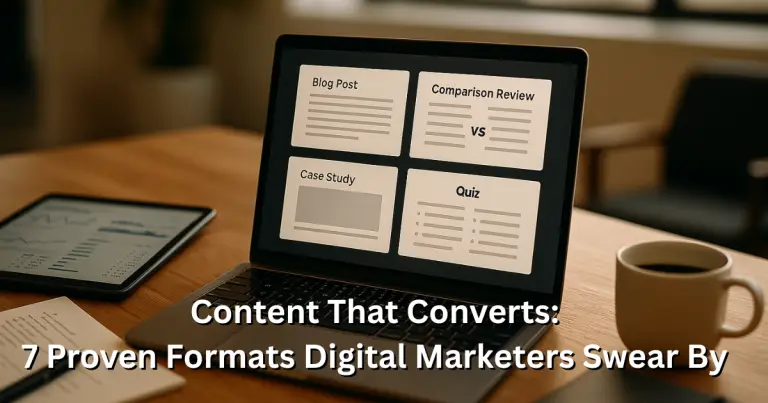Content That Converts:
7 Proven Formats Digital Marketers Swear By
Picture this: You’ve just launched your latest affiliate campaign, and your analytics show thousands of visitors hitting your site. Yet, your commission dashboard tells a different story—barely any conversions. Sound familiar?
If you’re nodding your head right now, you’re not alone. More than half of B2B marketers (55%) say it’s challenging to create content that prompts a desired action (e.g., conversions). The harsh reality is that while 87% of affiliate marketers focus on driving traffic, only the smartest ones understand that traffic without conversion is just expensive entertainment.
The game-changing difference between affiliate marketers who struggle and those who thrive isn’t just about finding the right products to promote—it’s about mastering the art of creating content that actually converts visitors into buyers. After analyzing thousands of successful affiliate campaigns and diving deep into conversion data, seven content formats consistently outperform everything else.
These aren’t theoretical concepts or marketing fluff. These are battle-tested formats that top affiliate marketers use to turn their content into conversion machines, often seeing 200-400% increases in their commission earnings within just a few months.
Why Most Affiliate Content Fails to Convert
Before we dive into the winning formats, let’s address the elephant in the room. Most affiliate content fails because it focuses on features rather than transformations. Generic product descriptions and basic “Top 10” lists don’t cut through the noise anymore. Today’s consumers are savvier, more research-driven, and incredibly skeptical of obvious sales pitches.
The average conversion rate across all e-commerce sites is under 2%, but the content formats we’re about to reveal can push your conversion rates well beyond this benchmark. The secret lies in creating content that doesn’t just inform—it persuades, guides, and ultimately compels action.
Smart affiliate marketers know that avoiding common affiliate marketing mistakes while implementing these high-converting formats creates a powerful combination that can dramatically boost earnings.
The 7 Content Formats That Convert Like Crazy
1. In-Depth Blog Posts with Strategic Affiliate Integration
Long-form blog content remains the backbone of successful affiliate marketing, but not all blog posts are created equal. The winners understand that the average blog post length is 1,400 words — more than 77% longer than ten years ago, and there’s a compelling reason for this trend.
The Conversion Magic: Strategic blog posts work because they build trust through valuable information before introducing affiliate products as natural solutions. They capture readers at different stages of the buying journey and guide them toward purchase decisions through storytelling and social proof.
Pros:
- SEO Powerhouse: Long-form content ranks higher and captures organic traffic for months or even years
- Authority Building: Comprehensive posts establish you as a trusted expert in your niche
- Multiple Conversion Opportunities: Natural placement points for various affiliate products throughout the content
- Social Sharing Potential: Valuable content gets shared, expanding your reach organically
- Evergreen Value: Well-crafted posts continue generating commissions long after publication
Cons:
- Time Investment: Requires significant research and writing time upfront
- Consistent Publishing Pressure: Search engines favor regularly updated sites
Pro Tip: Structure your posts with clear headings, include comparison tables, and weave affiliate links naturally into the narrative rather than dumping them at the end.
2. Detailed Comparison Reviews
Comparison content captures one of the highest-intent audiences in affiliate marketing. When someone searches “X vs Y,” they’re typically ready to buy—they just need help making the final decision.
The Conversion Magic: Comparison reviews work because they directly address the buyer’s main concern: “Which option is best for my specific situation?” By presenting balanced comparisons while subtly highlighting your preferred choice, you guide readers to confident purchase decisions.
Pros:
- High Purchase Intent: Targets readers actively comparing options before buying
- Multiple Revenue Streams: Can include affiliate links for all compared products
- Search Engine Gold: Comparison keywords often have high commercial intent and good search volume
- Decision-Making Support: Helps readers feel confident about their choice, reducing buyer’s remorse
- Shareability Factor: People love sharing helpful comparisons with friends facing similar decisions
Cons:
- Research Intensive: Requires hands-on experience with multiple products
- Update Maintenance: Products change features and pricing regularly
Pro Tip: Create comparison tables that highlight key differences, and always include a clear “winner” recommendation with strong reasoning to guide the final decision.
3. Case Studies and Success Stories
Nothing sells like proof that something actually works. Case studies tap into the powerful psychological principle of social proof while demonstrating real-world applications of the products you’re promoting.
The Conversion Magic: Case studies convert because they show transformation stories that readers can envision for themselves. Instead of abstract benefits, they provide concrete evidence of results, making the purchase decision feel safe and logical.
Pros:
- Trust Amplifier: Real results from real people overcome skepticism instantly
- Emotional Connection: Stories create emotional investment in the outcome
- Proof of ROI: Demonstrates clear value proposition with measurable results
- Versatile Content: Can be repurposed across multiple platforms and formats
- Authority Builder: Positions you as someone with access to successful people and strategies
Cons:
- Credibility Requirements: Need access to genuine success stories and data
- Time Sensitivity: Results may become outdated or less relevant over time
Pro Tip: Include specific metrics, before/after scenarios, and direct quotes from the people featured in your case studies to maximize authenticity and impact.
4. Interactive Quizzes and Assessments
Interactive content, such as apps, assessments, calculators, configurators and quizzes, generate conversions moderately or very well 70% of the time, compared to just 36% for passive content. This statistic alone should make quizzes a priority in your content strategy.
The Conversion Magic: Quizzes work by making the experience about the user rather than the product. They engage visitors actively, collect valuable data about preferences and needs, and provide personalized recommendations that feel tailored rather than pushy.
Pros:
- Engagement Explosion: Users spend more time interacting with your content
- Lead Generation Machine: The average quiz has a 31.6% lead capture rate
- Personalization Power: Delivers customized product recommendations based on individual responses
- Social Media Magnet: Highly shareable content that spreads organically
- Data Collection: Gathers valuable insights about your audience’s preferences and pain points
Cons:
- Technical Setup: Requires quiz-building tools or technical knowledge
- Content Planning: Needs well-thought-out questions and result pathways
Pro Tip: Design quiz results that naturally lead to specific affiliate products as solutions, and always collect email addresses before revealing results.
5. Short-Form Video Content
Short-form video is now the number one content marketing format for marketers and the one that delivers the highest return on investment (ROI). For affiliate marketers, video content creates trust faster than any other format because viewers can see and hear you directly.
The Conversion Magic: Video combines visual demonstration with personal connection. Viewers can see products in action, witness genuine reactions, and build parasocial relationships with creators, all of which dramatically increase purchase confidence.
Pros:
- Trust Building Accelerator: Face-to-face connection builds relationships faster than text
- Product Demonstration: Shows products in action, addressing buyer concerns visually
- Algorithm Favoritism: Social platforms heavily promote video content in their feeds
- Multi-Platform Power: One video can be repurposed across YouTube, TikTok, Instagram, and more
- Higher Engagement: Video content consistently receives more likes, shares, and comments
Cons:
- Equipment Investment: May require camera, lighting, and editing software
- Comfort Zone Challenge: Not everyone feels natural on camera initially
Pro Tip: Focus on providing value first—tutorials, tips, or entertainment—then naturally incorporate affiliate products as solutions or recommendations.
6. Email Marketing Sequences
Email marketing is one of the most effective channels for driving conversions, with a 2.8% conversion rate for B2C brands. For affiliate marketers, email sequences allow for repeated exposure and relationship building that single-touch content can’t achieve.
The Conversion Magic: Email sequences work through consistent value delivery and gradual trust building. They allow you to educate subscribers, address objections, share success stories, and present affiliate offers at precisely the right moment in the buyer’s journey.
Pros:
- Relationship Building: Direct communication channel builds stronger connections
- Multiple Touchpoints: Can present offers several times in different contexts
- Segmentation Power: Tailor messages based on subscriber interests and behaviors
- Automation Potential: Set up once and generate passive affiliate income
- High ROI Channel: Consistently delivers strong returns on investment across industries
Cons:
- List Building Required: Need to build an email list before sequences become effective
- Deliverability Challenges: Must maintain good sending practices to avoid spam filters
Pro Tip: Use storytelling in your sequences, share personal experiences with products, and always provide value before making affiliate offers.
7. Resource Guides and Ultimate Lists
Comprehensive resource guides position you as the go-to authority in your niche while naturally incorporating multiple affiliate opportunities. These content pieces become bookmark-worthy references that generate traffic and commissions for months or years.
The Conversion Magic: Resource guides convert because they serve as one-stop solutions for complex problems or goals. Readers trust curated recommendations from experts who’ve done the research, making them more likely to act on affiliate suggestions.
Pros:
- Authority Positioning: Establishes you as the definitive expert in your niche
- Multiple Revenue Opportunities: Can include dozens of relevant affiliate products
- Evergreen Traffic: Continues attracting visitors and generating commissions long-term
- Link Magnet: Other sites link to comprehensive resources, boosting SEO
- Time-Saving Value: Provides immense value by curating and organizing information
Cons:
- Research Intensive: Requires extensive investigation and organization of information
- Regular Updates: Need periodic refreshing to maintain accuracy and relevance
Pro Tip: Organize guides with clear categories, include brief explanations for each recommendation, and update them quarterly to maintain freshness and relevance.
The Psychology Behind High-Converting Content
Understanding why these formats work is as important as knowing how to create them. Each successful format taps into fundamental psychological principles:
Social Proof: Case studies and reviews provide evidence that others have succeeded Authority: Comprehensive guides and blog posts establish expertise and trustworthiness Reciprocity: Valuable free content creates obligation to consider recommendations Personalization: Quizzes and targeted emails make readers feel understood and catered to Demonstration: Videos show rather than tell, reducing uncertainty about purchases
Implementation Strategy for Maximum Results
The most successful affiliate marketers don’t rely on just one format—they create ecosystems of content that work together. Here’s how to implement these formats strategically:
Start with Research: Use tools like Google Keyword Planner, SEMrush, or Ahrefs to identify high-intent keywords in your niche that align with these content formats.
Create Content Clusters: Build topic clusters around your main affiliate products, using different formats to address various aspects and buyer concerns.
Cross-Promote: Link between different content types—mention your detailed reviews in blog posts, reference case studies in email sequences, and embed quizzes in resource guides.
Track and Optimize: Monitor which formats drive the most conversions for your specific audience and double down on what works best.
The Future of Affiliate Content
As we move further into 2025, successful affiliate marketers are those who adapt these proven formats to emerging technologies and platforms. Personalization has always been an important part of the content marketing process, and it will be even more vital in 2025.
The affiliate marketers who thrive will be those who combine these time-tested formats with personalization technology, AI-powered insights, and multi-channel distribution strategies.
Your Next Steps
Now that you understand the seven content formats that consistently convert, your success depends on implementation. Start with the format that aligns best with your current skills and resources, then gradually expand your content arsenal.
Remember: the difference between affiliate marketers who struggle and those who succeed isn’t talent or luck—it’s using the right content formats consistently and strategically. These seven formats have generated millions in affiliate commissions because they address real human psychology and behavior patterns that don’t change, regardless of market trends.
Choose one format from this list, commit to mastering it over the next 30 days, and watch as your conversion rates—and commission checks—start reflecting the quality of content your audience actually wants to consume.
The question isn’t whether these formats work (the data proves they do). The question is: which one will you implement first to transform your affiliate marketing results?




